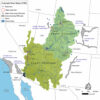Water scarcity could affect three billion more people than previously expected by mid-century, with increased pollution rendering river sources “unsafe” for humans and wildlife, researchers warned Tuesday.
The UN’s climate science panel has said that around half the world’s population currently faces severe water scarcity for at least a month a year and warned that global warming impacts and rising demand are key risks to global supply.
But new research by scientists in Germany and the Netherlands has found that if harmful nitrogen pollution is factored in the number of areas considered water scarce increases dramatically.
“In general, people worry more about water scarcity—whether you have enough water,” lead author Mengru Wang, of Wageningen University & Research, told AFP.
“But I also see that water pollution is really becoming a more and more important issue that makes water unsafe to be used by nature and humans.”
Human activities are spewing large amounts of nitrogen, pathogens, chemicals and plastics into water systems.
Nitrogen, from agricultural fertilizers in particular, contributes to algae growth that can choke waterways, threaten marine life and compromise water quality.
The new study, published in the journal Nature Communications, analyzed river basins around the world, which are key sources of drinking water and hubs for urban and economic activities.
According to the authors’ computer modeling, the number of sub-basins—smaller units in the river basins—facing severe water scarcity was twice as much as previously thought in 2010 and could get much worse in the coming decades.
They estimate that in 2010, 2,517 sub-basins in the world were facing water scarcity, when nitrogen pollution’s impact on water quality was taken into account, compared with just 984 according to conventional assessments based on quantity.
That figure could rise to up to 3,061 by 2050, they found, estimating this would affect roughly 6.8 to 7.8 billion people—or roughly three billion more than in conventional estimates.
Co-author Benjamin Bodirsky, senior scientist at the Potsdam Institute for Climate Impact Research, said the modeling of three different scenarios that affected pollution levels showed “we do have choices and can improve the situation”.
But he said that even in the most optimistic estimates, nitrogen pollution would stay at “substantial levels” in important agricultural areas like Europe, China and India.
“The deterioration of water access can be halted, and to some extent even reversed, by adopting more efficient fertilizer use as well as more vegetarian diets, and by connecting a larger proportion of the global population to water treatment facilities,” Bodirsky said.
More information:
Mengru Wang et al, A triple increase in global river basins with water scarcity due to future pollution, Nature Communications (2024). DOI: 10.1038/s41467-024-44947-3
2024 AFP
Citation:
Pollution risks worsening global water scarcity: Study (2024, February 6)



